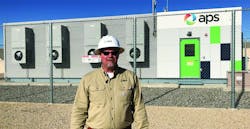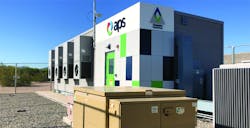APS Grid-Scale Batteries Backup Solar, Smooth the Grid
In the Valley of the Sun (Arizona), solar power suddenly seems to be everywhere, as you might expect.
Everywhere, that is, until the night comes or, as was the case mid-day on Aug. 21, 2017, when a full solar eclipse meant the sun would be gone from the midday sky, if even for just a few moments.
Both that one-time eclipse and the daily night sky have given Arizona Public Service (APS) ample opportunity to use, observe and test two grid-scale 2 MW battery storage arrays designed for just that purpose — to both backup solar power and smooth the grid when solar is disrupted or unavailable.
APS is currently deploying two identical 2 MW/2 MWh grid-scale batteries on two suburban Phoenix feeders — Festival Ranch and McMicken — that help supply the cities of Surprise and Buckeye, Arizona.
APS’ 2-MW McKicken energy storage battery sits just outside Phoenix, Arizona.
The batteries are part of a larger pilot project APS has embarked on to learn how to better integrate the growing amount of intermittent renewable energy resources into its system, especially private rooftop solar. Energy storage in the form of the batteries has the potential to smooth out gaps in solar production when clouds pass over panels, as well as deliver surplus solar energy captured during midday to customers as they arrive home from work and the sun goes down.
The two batteries have been integrated into the company’s Solar Partner Program, a project that includes 1500 customers. Participating customers are receiving US$6000, which is broken out into US$30 per month payments over the next 20 years, to install a collective 10 MW of photovoltaic rooftop solar panels so the company can study the use of smart inverters and energy storage. APS wants to learn how improve reliability for customers in areas where a penetration of solar has created instability in the system. The information APS is gaining from this study will help craft what the future of renewable energy integration looks like for utilities across the country.
“The best renewable energy is the type a customer never thinks about. A light goes on, a load of towels gets washed and life goes on as reliable as ever before, all powered by the sun,” said Scott Bordenkircher, APS’ director of technology innovation.
Scott Bordenkircher, Arizona Public Service’s Director of Technology Innovation, stands next to racks of lithium-ion batteries stored inside the company’s 2-MW McKicken Battery Storage cabinets that resemble gym lockers.
Construction began on the two batteries in late 2016 and they became operational in early 2017, supplying power to up to 1000 homes for an hour. More critical than the total load, the batteries displace more expensive resources at times of peak customer demand, while also providing substantial information that will help the utility decide when where and how much energy storage to deploy in coming years. This is particularly important for APS, with company projections forecasting population and economic growth in Arizona that will increase the state’s energy needs by as much as 25% by 2025.
A related goal is to move as much generation as the utility can to controllable and renewable energy sources that can help minimize CO2 emissions.
What Happened When the Sun Disappeared
Back to the eclipse of August 2017, which allowed APS the perfect opportunity to study how energy storage can minimize a big issue with solar power — how to replace it when the sun does not shine and solar power resources stop producing completely. That can be disruptive — even destructive — to customers, to the grid and to sensitive equipment on both or either side of the electric meter.
The two batteries reside in what is now relatively empty land several miles outside of Phoenix, but in areas where APS expects future population growth, which will make them even more valuable as homes and businesses migrate further out from the city. Each site contains a sleek, single-story, supercooled steel structure that contains 32 cabinets resembling lockers a high school basketball team might use. Each cabinet is filled with modular units called nodes that together make up the 2 MW batteries.
Display screens inside the APS Solar Energy Center let operators remotely view and monitor each battery’s operation.
They are also installed at different points on the feeders to see if location adds value to power quality and reliability for customers. The Festival Ranch battery is installed at mid-circuit, while the McMicken unit is contained at the head of the feeder in an existing substation.
The battery arrays were primed and ready to go the day of the eclipse. Both batteries were fully charged before the eclipse began. As the moon began passing in front of the sun they were discharged to power load precisely. As expected, the needle never moved.
“It was as if the eclipse never happened,” said Erik Ellis, manager of energy technology assessment at APS. “The batteries responded perfectly and sustained their performance through the entire event. We wanted to know if they could help maintain reliable service to customers. They passed their first major test with flying colors.”
Balancing the Grid
Reliability is essential, but only part of the story, as APS takes the lead among electric utilities across America in understanding and deploying energy storage resources. Solar power is clean and abundant, but the way it is utilized today — on rooftops scattered across the system — can be disruptive. When power is produced at a specific point along the distribution system, voltage is increased at that point, which can be problematic. The system must be kept in balance or it will become unstable. Sensitive equipment can easily be damaged and large swaths of customers could lose service. Power quality could be at risk, wreaking further havoc. These are well-known issues, but can become more prevalent with the presence of so much private solar newly installed on the system. APS presently has more than 80,000 private solar installations in its territory alone.
Advanced inverters for solar and energy storage systems can enable grid operators to maintain proper control and keep power flowing seamlessly. Inverters transform DC power to AC power so it can used by customers; advanced inverters allow the utility to have a measure of control over the private solar array to better maintain system voltage within desired ranges, thus protecting sensitive appliances like computers, HD televisions and other important devices that run off electricity.
“We have learned so far that energy storage is superior to advanced inverters in allowing us to operate the system as needed,” Bordenkircher said. “Both are important, but medium-sized batteries like those at Festival Ranch and McMicken are the bigger wrestler in the ring. If every inverter was an advanced inverter, we would be good to go, but they are not. Batteries can act as a grid regulator and enable us to restore stability to the sections of our system where we have high solar penetration.”
Bordenkircher noted that the battery pilots have produced invaluable data. As a result of a single year of operating the energy storage at Festival Ranch and McMicken, APS has learned the following:
- How to operate and utilize battery storage
- How to operate batteries and advanced inverters together so they work in tandem
- How to use batteries to minimize or prevent outages
- Where batteries are best deployed
- How to follow the load and voltage and a combination of the two
- How to relieve the local grid during times of peak usage extending equipment life
- The ideal rate of charging and discharging the batteries
“We have found problems and solutions and we have shared that information far and wide, including our research partner EPRI, which we believe will lead to greater innovation and broader solutions,” said Bordenkircher. “The work that is being done on energy storage here in Arizona is truly groundbreaking. It is important work and a part of our contribution to the energy welfare of our state and customers.”
In the end, electric utility customers will benefit the most. Energy storage, Bordenkircher said, is expensive today but will become more economical as it becomes more commonplace and more efficient. Utilities will continue to develop new and expanded uses for storage and its full range of applications.
“Not all that far into the future our customers will live in homes that are powered by resources that are leaner and smarter — and ultimately less expensive,” said Bordenkircher. “The batteries at Festival Ranch and McMicken are an early step toward that future, but an important step. Projects like this will us to decide how best to deploy advanced technology. The lessons we learn here will resonate for years.”



